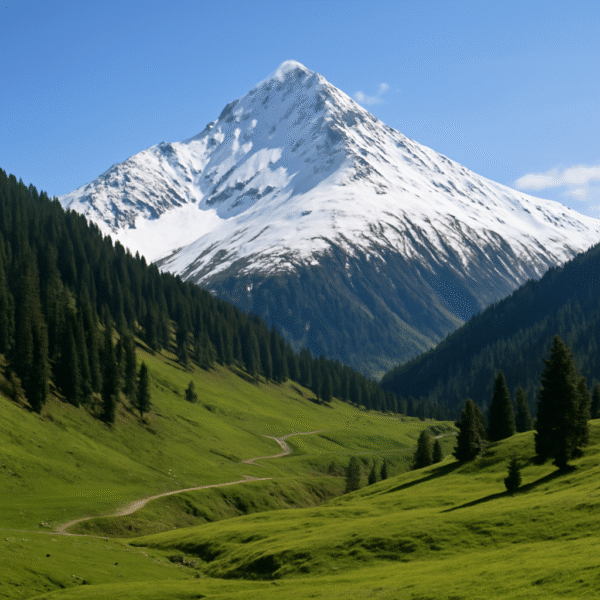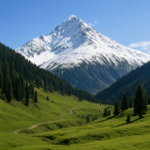Nestled in the snow-clad expanse of Jammu and Kashmir’s Doda district, Dagan Top is quietly rising as one of India’s most enthralling offbeat travel destinations. Located in the remote Gandoh region of the Bhalessa Valley, this hidden gem offers a tranquil blend of soaring snowy peaks, lush green meadows, and authentic Pahari nomadic culture—making it a haven for eco-conscious travelers in search of raw, immersive experiences.
A Landscape Untouched by Mass Tourism
Dagan Top’s elevation above sea level and its seclusion from major tourism routes have kept it largely untouched by commercial development. Accessible only via the Kilhotran–Changa road from Doda followed by a trek through hamlets like Kota, Bonencha, and Kakoti, the destination demands a bit of adventure to reach—yet this challenge only enhances its allure.
With no direct roads or large-scale infrastructure, Dagan Top rewards visitors with unspoiled alpine beauty and panoramic views that stretch across the valleys of Chamba in Himachal Pradesh and Doda in Jammu and Kashmir. The nearby meadows of Gamgul, Shinkri, Makan, and Chasool are richly forested and ideal for hiking, while the rugged terrains of Mandral, Jawali, and Talaie invite seasoned trekkers to explore lesser-known trails.
A Cultural Mosaic of Nomadic Life
Every summer, Dagan Top transforms into a seasonal haven for nomadic communities such as the Gujjars, Bakkerwals, and ethnic Kashmiris. These groups bring their herds to graze in the fertile meadows, keeping alive pastoral traditions that span generations. Visitors are welcomed into a vibrant living culture where shepherd huts, folk songs, and open-fire cooking define the rhythm of rural Himalayan life.
The region’s deep cultural authenticity—from the oral storytelling of elders to traditional livestock rearing methods—offers a tourism experience that is both educational and emotionally enriching. Unlike commercial hill stations, here the culture is not staged but lived.
Winter Magic and Outdoor Adventure
When winter blankets Dagan Top in deep snow, the region transforms into a white wonderland ideal for snow trekking, wildlife photography, and peaceful solitude. The untouched snowfields and the silence of high-altitude coniferous forests offer a meditative experience that is increasingly rare in today’s busy tourist circuits.
Despite its immense potential for adventure tourism, the region lacks winter infrastructure—no formal shelters, rest houses, or rescue stations currently exist. However, this rawness also ensures a low-impact footprint, attracting nature enthusiasts who value authenticity over amenities.
Sustainable Tourism Potential and Government Interest
Dagan Top’s potential has caught the attention of regional authorities. Under the leadership of Lieutenant Governor Manoj Sinha, Jammu and Kashmir’s tourism department has begun identifying lesser-known sites to promote under its “Offbeat Destinations” campaign. The aim is to diversify tourism beyond Srinagar and Gulmarg, promoting rural economic development while preserving cultural and environmental heritage.
According to the Jammu and Kashmir Tourism Department, eco-tourism and homestay development in regions like Doda and Bhalessa are part of the broader vision to create community-based tourism models. These models prioritize local ownership, minimal environmental disruption, and the empowerment of tribal and nomadic populations.
Challenges and the Road Ahead
While Dagan Top’s seclusion is part of its charm, it also presents serious challenges. Lack of basic amenities, including mobile connectivity, tourist reception centers, and sustainable lodging, hampers long-term viability. Seasonal access is difficult, especially in winter, requiring strategic planning for infrastructure without disturbing the natural habitat.
Experts from the Ministry of Tourism and J&K Forest Department suggest introducing low-impact interventions like eco-trails, viewing decks, and glamping pods. Collaborations with NGOs and eco-tourism startups could help train locals in sustainable hospitality and encourage responsible visitor behavior.
Moreover, mapping the rich biodiversity of the surrounding forests—which are home to Himalayan flora and possibly species like the musk deer and monal pheasant—could open the door for nature-based tourism and eco-safaris, supported by conservation-led initiatives.
A Model for Responsible Travel in the Himalayas
Dagan Top represents a rare opportunity to redefine how we experience the Himalayas. Rather than another overdeveloped hill destination, it offers a model for slow travel, where cultural immersion, nature appreciation, and mindful adventure co-exist.
For Indian and international travelers seeking to explore less-trodden paths, Dagan Top invites exploration, not exploitation. Its untamed beauty, pastoral charm, and nomadic authenticity are best experienced with humility and reverence. If approached wisely, Dagan Top could become a benchmark for India’s future of regenerative, community-owned tourism.
How to Reach Dagan Top
- Nearest Airport: Jammu Airport (approx. 240 km)
- Nearest Railhead: Udhampur or Jammu Tawi
- By Road: From Doda via Kilhotran–Changa road; last leg by foot or horseback
- Best Time to Visit:
- Summer (May–October): Ideal for cultural experiences and meadow treks
- Winter (November–March): Best for snow treks and solitude seekers
Conclusion:
In a world of fast-paced, commodified tourism, Dagan Top offers a profound reminder that true travel lies in discovery, connection, and respect. As Jammu and Kashmir continues to highlight its lesser-known wonders, this remote peak stands ready to welcome the world—with open skies, untouched trails, and stories yet untold.
For more travel news like this, keep reading Global Travel Wire





















